Python的惊人技巧
Python是一种了不起的编程语言,由于其庞大的库集,可以执行许多有趣的事情。以下是一些常见的技巧,以及对编程有帮助的内容。
SS在python中多次打印相同的字符。
通过多次键入相同的字符集来打印重复的字符,或者在值较大时循环遍历,这在其他编程语言中很常见。但是python在其主干中还有其他东西可以简化递归字符的打印。
以下代码用于在python中打印递归字符,
示例
print("I love program at tutorials point "+"TP"*4);输出结果
I love program at tutorials point TPTPTPTP
以不同方式打印列表元素
List就像一个不均匀的数组。为了在python中打印列表的元素,定义了多种方法。默认情况下,在python中打印列表时,会加上方括号和单引号。但是在python中,您可以选择以更有效的方式打印列表。这项工作是在python中使用join()方法完成的。
join方法将列表转换为字符串。列表中的每个元素都与称为联接的字符串相连。让我们看看它是如何工作的。
示例
bikes = ['thunderbird' , 'Pulsar' , 'R15' , 'Duke']# traditional method of printing the list
print("Bikes are :", bikes)
# printing list using join method
print("Bikes are : %s" %','.join(bikes))
print('Bikes are : ',(" and ".join(bikes)))
输出结果
Bikes are : ['thunderbird', 'Pulsar', 'R15', 'Duke']Bikes are : thunderbird,Pulsar,R15,Duke
Bikes are : thunderbird and Pulsar and R15 and Duke
同时打印多个列表
Python提供了一种以成对形式同时打印多个列表元素的方法。有一种称为zip的方法,可以将两个等长列表合并成对。
示例
bikes = ['thunderbird' , 'Pulsar' , 'R15' , 'Duke']speed = ['142' , '135' , '137' , '145']
for bike, maxspeed in zip(bikes , speed):
print(bike, maxspeed)
输出结果
thunderbird 142Pulsar 135
R15 137
Duke 145
交换值的ShortHand技巧
Python编程语言支持一个内置的速记技巧来交换两个值。此技巧提供了一种无需使用任何额外变量即可交换值的简便方法。我们来看一个显示其工作原理的程序-
示例
value1 = 325value2 = 976
print("value1 = ",value1)
print("value2 = ",value2)
value1,value2 = value2,value1
print("\nSwapped values")
print("value1 = ",value1)
print("values = ",value2)
输出结果
value1 = 325value2 = 976
Swapped values
value1 = 976
values = 325
在Python中反转字符串
Python提供了一种简单的技巧来反转字符串。我们来看一个如何在python中反转字符串的示例-
示例
value1 = 'Hello! Welcome to tutorials point'print(value1[::-1])
number = 934827165303
print(int(str(number)[::-1]))
输出结果
tniop slairotut ot emocleW !olleH303561728439
通过python中的函数返回多个值
在python中,该函数可以在python中返回多个值,即您可以返回多个值而不是单个值。
示例
def multiple() :return 1*3 , 2*3 , 3*3 , 4*3 , 5*3
val1, val2, val3, val4, val5 = multiple()
print(val1, val2, val3, val4, val5)
输出结果
3 6 9 12 15
在for-in循环中打印索引和值
在python中,使用for-in循环对值进行循环仅产生值。但是,如果我们也想访问索引,则需要使用一个枚举,该枚举将返回带有值的索引。
让我们看一个如何工作的例子-
示例
bikes = ['thunderbird' , 'Pulsar' , 'R15' , 'Duke']for i, bike in enumerate(bikes) :
print(i, bike)
输出结果
0 thunderbird1 Pulsar
2 R15
3 Duke
python中的切片操作
python中的slice操作用于从列表中获取项目。让我们看一个切片操作如何工作的例子-
示例
bikes = ['thunderbird' , 'Pulsar' , 'R15' , 'Duke', 'S1000RR']print(bikes[0:3]) #print first 3 elements
print(bikes[::2]) #print alternate elements
print(bikes[::-1]) #prints reversed list
print(bikes[::-2]) #prints reversed list with alternate elements
输出结果
['thunderbird', 'Pulsar', 'R15']['thunderbird', 'R15', 'S1000RR']
['S1000RR', 'Duke', 'R15', 'Pulsar', 'thunderbird']
['S1000RR', 'R15', 'thunderbird']
将字符串转换为python中的列表
有时有一种将输入的字符串转换为其他类型的冲动。因此,这是python中的一种方法,用于将字符串转换为python中的列表。让我们看看它是如何完成的-
示例
name = "3 34 67 12 78"converted_list = list(map(int, name.split()))
print(converted_list)
输出结果
[3, 34, 67, 12, 78]
将列表的列表转换为单个列表
在python中,多维列表可以转换为一维列表。方法chain.from_iterable()用于此任务。因为它从列表的列表中返回元素,直到遇到最后一个元素。让我们看一个如何工作的例子-
示例
import itertoolsdob = [ [3 , 30], [6 , 12] , [8 , 17] ]
print(dob)
dates = list(itertools.chain.from_iterable(dob))
print(dates)
输出结果
[[3, 30], [6, 12], [8, 17]][3, 30, 6, 12, 8, 17]
以上是 Python的惊人技巧 的全部内容, 来源链接: utcz.com/z/331569.html







